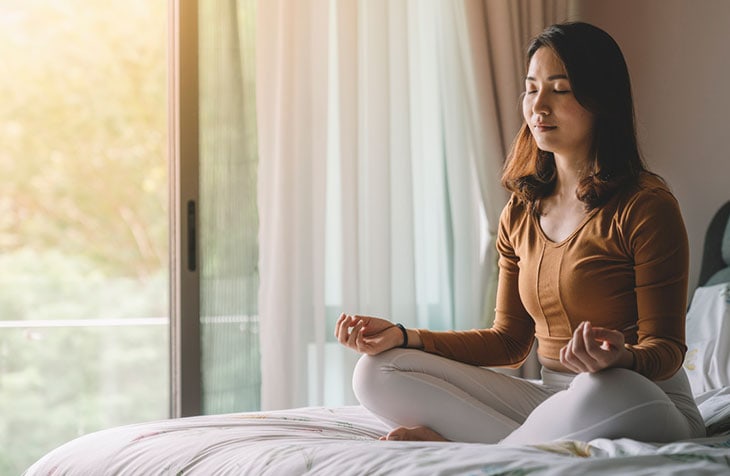Deep Relaxation With Transcendental Meditation: Step-By-Step Guide

Are you looking for a way to achieve deep relaxation and inner peace? Look no further than Transcendental Meditation. In this step-by-step guide, we will show you how to practice this powerful technique.
Discover the benefits of deep relaxation and learn how to prepare yourself for a transformative experience. Find a quiet space, adopt a comfortable posture, choose a mantra, and get ready to embark on a journey of tranquility and self-discovery.
Let’s begin!
Key Takeaways
- Transcendental Meditation impacts state of consciousness
- Mantra helps focus and calm the mind
- Deep relaxation promotes inner peace and reduces stress
- Choosing a comfortable posture and a suitable mantra enhances the meditation experience
Understanding Transcendental Meditation
To fully grasp the concept of Transcendental Meditation, you’ll need to understand its profound impact on your state of consciousness.
One of the key elements of Transcendental Meditation is the use of a mantra. A mantra is a specific word or sound that you repeat silently to yourself during meditation.
Research has shown that the effectiveness of the mantra lies in its ability to help focus and calm the mind. Scientific studies have demonstrated that practicing Transcendental Meditation with a mantra can lead to decreased stress, improved cognitive function, and increased overall well-being.
The repetitive nature of the mantra allows the mind to settle into a state of deep relaxation, promoting a sense of inner peace and clarity.
Benefits of Deep Relaxation
You’ll experience numerous benefits from practicing this form of meditation. Transcendental meditation is not just about finding inner peace; it also offers a range of benefits for your mind and body.
Here are four key benefits you can expect:
- Reduced stress levels: By engaging in deep relaxation techniques, such as transcendental meditation, you can effectively reduce your stress levels. This practice allows you to let go of the daily pressures and find calmness within.
- Improved focus and concentration: Regular practice of transcendental meditation can help sharpen your focus and enhance your concentration abilities. This can be particularly beneficial in today’s fast-paced world where distractions are abundant.
- Increased overall well-being: Deep relaxation through transcendental meditation promotes a sense of overall well-being. It can help you feel more balanced, rejuvenated, and centered in your daily life.
- Enhanced physical health: Studies have shown that practicing transcendental meditation can have positive effects on physical health. It can lower blood pressure, boost immune system function, and improve sleep quality.
Start incorporating transcendental meditation into your routine and reap the benefits of deep relaxation and stress reduction.
Preparing for Transcendental Meditation
Get ready for your transcendental meditation practice by finding a quiet and comfortable space.
Mindfulness meditation offers numerous benefits, including reduced stress, improved focus, and increased self-awareness.
To achieve deep relaxation during your meditation practice, it is important to follow a few techniques.
Start by finding a comfortable seated position, either on a cushion or a chair with your back straight.
Close your eyes and take a few deep breaths to center yourself.
Focus your attention on your breath, observing the sensation of each inhale and exhale.
If your mind wanders, gently bring your attention back to your breath.
Allow any thoughts or emotions to come and go without judgment.
With continued practice, you will gradually experience a deep sense of relaxation and inner peace.
Step 1: Finding a Quiet Space
Finding a quiet and comfortable space is essential for your mindfulness meditation practice. In order to truly find inner peace and create a meditation routine, it is important to have a dedicated space where you can fully relax and focus.
Here are four key elements to consider when finding your ideal meditation space:
- Peaceful Environment: Look for a space that is free from distractions and noise, allowing you to fully immerse yourself in the practice.
- Comfortable Seating: Find a cushion or chair that supports your body in a comfortable and upright position, promoting relaxation and a clear mind.
- Natural Light: If possible, choose a space with natural light to create a calming and uplifting atmosphere.
- Personal Touch: Add personal touches such as calming scents, soft lighting, or soothing music to enhance your meditation experience.
Step 2: Adopting a Comfortable Posture
To fully immerse yourself in the practice of mindfulness meditation, it’s important to adopt a comfortable posture that supports relaxation and focus. The way you sit during meditation can greatly impact your experience and the effectiveness of the practice. Proper posture helps in aligning your body, allowing for better circulation and easing tension. It also helps in maintaining alertness and preventing drowsiness. There are different meditation postures you can choose from, each with its own effects on relaxation. Here is a table to give you an overview:
| Posture | Effects on Relaxation |
|---|---|
| Full Lotus | Deepens concentration |
| Half Lotus | Balances energy |
| Burmese | Supports stability |
| Seated Chair | Promotes comfort |
| Lying Down | Induces relaxation |
Explore these postures and find the one that suits you best. Remember, a comfortable posture sets the foundation for a successful meditation practice.
Step 3: Choosing a Mantra
Now it’s time to move on to step 3: choosing a mantra.
This is an important step because finding the perfect sound can greatly enhance your meditation experience. Personalizing your mantra allows you to connect with it on a deeper level, making it more meaningful and effective.
Finding the Perfect Sound
Once you’ve settled into a comfortable position, start by focusing on the sound that resonates within your mind. Allow your thoughts to drift away as you dive into the realm of deep relaxation. Sound therapy can be a powerful tool in achieving inner peace and tranquility.
When choosing a mantra, consider exploring different mantras to find the perfect sound that resonates with your being. Here are a few options to consider:
- Om: This ancient Sanskrit mantra is believed to represent the sound of the universe, bringing harmony and balance to your mind and body.
- So Hum: Derived from the sounds of inhalation and exhalation, this mantra helps you connect with your breath and cultivate a sense of self-awareness.
- Shanti: Meaning ‘peace’ in Sanskrit, this mantra can help calm the mind and invite serenity into your life.
- Om Shanti Shanti Shanti: By repeating this mantra, you can invoke peace on all levels – physical, emotional, and spiritual.
Explore these different mantras and find the one that resonates with you the most. Remember, the sound you choose should bring you a sense of calm and inner stillness.
Personalizing Your Mantra
When personalizing your mantra, it’s important to choose words that deeply resonate with your heart and soul. The power of your mantra lies in the meaning and connection it holds for you. So, take some time to reflect on what truly speaks to you, what brings you peace and joy.
Consider using words that embody your intentions and desires, words that uplift and inspire you. Experiment with different mantra techniques, such as repeating your chosen words silently or out loud, or even writing them down.
Importance of Mantra Selection
Choosing the right words that deeply resonate with you is crucial when personalizing your mantra for maximum effectiveness and connection. Your mantra serves as a powerful tool to quiet the mind and bring about a state of deep relaxation.
To ensure its effectiveness, it is important to pay attention to the pronunciation of your chosen words. When reciting your mantra, pronounce each syllable clearly and with intention. This will help to create a rhythm and flow that enhances the overall experience.
To further enhance the effectiveness of your mantra, consider the following:
- Select words that hold personal meaning and significance.
- Choose words that evoke positive emotions and feelings.
- Experiment with different mantras to find the one that resonates best with you.
- Practice reciting your mantra regularly to establish a deeper connection with it.
Step 4: Practicing Transcendental Meditation
If you’re new to meditation, you may be wondering about its benefits and how to get started.
Meditation offers a wide range of benefits, including reduced stress, improved focus, and increased self-awareness.
As a beginner, it’s important to start with simple practices, find a quiet space, and set aside dedicated time each day to cultivate a meditation routine that works for you.
Benefits of Meditation
One of the benefits of meditation is that it can help reduce stress and anxiety. By incorporating a regular meditation practice into your daily routine, you can significantly improve your mental health and well-being.
Here are some ways in which meditation can help you in reducing stress levels:
- Promotes relaxation: Meditation promotes deep relaxation by activating the body’s relaxation response, which helps to reduce stress hormones and induce a state of calmness.
- Enhances self-awareness: Through meditation, you can develop a greater sense of self-awareness, allowing you to identify and manage stress triggers more effectively.
- Improves focus and concentration: Regular meditation practice can enhance your ability to stay focused and concentrate, reducing the impact of stress on your mental well-being.
- Boosts emotional well-being: Meditation can help you cultivate positive emotions, such as joy, gratitude, and compassion, which can counteract the negative effects of stress and anxiety.
Incorporating meditation into your daily routine can have a profound impact on your mental health, helping you to reduce stress levels and improve overall well-being.
Tips for Beginners
When starting out with meditation, it’s important to find a quiet and comfortable space where you can focus and relax. Sit in a position that feels natural to you, whether it’s sitting cross-legged on the floor or on a cushion.
Begin by taking a few deep breaths, inhaling through your nose and exhaling through your mouth. This will help you calm your mind and get into a relaxed state.
As you continue with your practice, try different breathing techniques, such as deep belly breathing or counting your breaths. These techniques can help you become more present and focused.
To make meditation a habit, try to create a routine. Set aside a specific time each day to meditate, whether it’s in the morning or before bed.
Frequently Asked Questions
How Long Does It Take to See the Benefits of Deep Relaxation Through Transcendental Meditation?
You’ll start experiencing the benefits of deep relaxation through transcendental meditation within a few weeks. Incorporate it into your busy schedule by setting aside 20 minutes twice a day for practice.
Can I Practice Transcendental Meditation in a Noisy Environment?
Yes, you can practice Transcendental Meditation in a noisy environment. It may be challenging, but with perseverance, you can still experience the benefits of TM, even in a stressful and busy schedule.
Is It Necessary to Practice Transcendental Meditation at the Same Time Every Day?
It’s not necessary to practice Transcendental Meditation at the same time every day, but having a flexible schedule allows you to reap the benefits of consistent practice.
Can I Use Any Word or Sound as a Mantra for Transcendental Meditation?
Yes, you can use any word or sound as a mantra for transcendental meditation. However, using specific mantras recommended by a qualified teacher can enhance the benefits and deepen your practice.
Are There Any Specific Dietary Guidelines to Follow Before Practicing Transcendental Meditation?
Before practicing transcendental meditation, it’s important to follow specific dietary guidelines. These guidelines can help create an optimal state of mind and body, enhancing the overall experience of deep relaxation.








